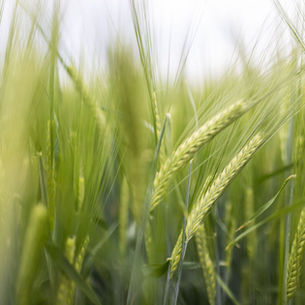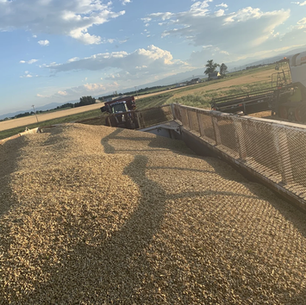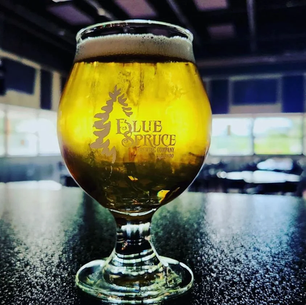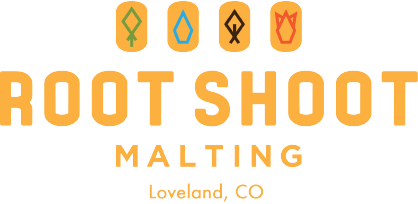top of page


All Posts


Six Ways to Pilsner: Why Variety Matters More Than You Think
The clean, crisp, golden backbone of beer. Most brewers know it, love it, and order it without much debate. But here’s a hot take: if you’re only thinking about COA specs (protein, color, extract) you’re missing out on an entire dimension of creative brewing.
Aug 11, 20254 min read


Root Shoot Malting 2025 Harvest Report: Winter Barley’s Best Year Yet
Harvest 2025 is wrapped, and wow, what a ride! We’re officially in the books with around 3 million pounds of barley safely tucked in storage bins, enough to fuel about a year and a half of malting magic here at Root Shoot. But beyond the numbers, this season felt like a big step forward in mastering winter barley, pushing regenerative practices, and learning the fine art of farming without a manual (because Mother Nature likes to keep us on our toes).
Aug 11, 20253 min read


Root Shoot's Malt Cup Madness: 15 Medals and Counting...
March 1st, 2025 the Craft Maltsters Guild hosted the 7th annual Craft Malt Cup and Root Shoot continued its winning streak! If malt had an Olympic team, we’d be waving a flag right now. For the seventh straight year, Root Shoot has medaled at the Malt Cup, making us the only malthouse to do so since the competition began. That’s 15 medals total since 2019, spread over 9 different varieties of malt we make.
Mar 4, 20254 min read


Be(er) Our Valentine
From your favorite malthouse in Loveland, our very own Adam Gurtshaw crafted FOUR malt-forward, valentine-themed beer recipes just for YOU. Featuring Root Shoot malts, these recipes are sure to give you a grain crush!
Jan 17, 20251 min read


Eight Years of Beers // Field Day 2024 Fun Facts (and Photos!)
We never truly got a chance to say thank you! To each and every one of you who came out to celebrate EIGHT years with us…and those who helped Field Day happen!
Sep 9, 20243 min read


Same As It Ever Was
Remember studying the Nile River and ancient Egypt in school? It’s the stuff of legends for elementary school students: huge pyramids, lion-looking sphynx, and images of strange creatures, humans with animal heads carved into rock. Always, in these primary lessons of world history, time is spent studying the Nile. The longest river in the world! Its annual flooding provided rich soil! Ancient Egyptians were master farmers even building irrigation systems to water their crops!
Jul 9, 20243 min read


Where Does (Our) Water Come From?
It’d be great if it rained water from the sky.
Rumor has it that that actually happens in parts of the country. Word is, that there are areas so wet and humid that farmers can actually grow crops using nothing but soil, sun, and water that - apparently - just comes on its own. Just falls from the clouds without pivots, ditches, or pipes.
Jun 8, 20243 min read


Field Notes for Farm Nerds: So Many Seeds
Often in our posts, you’ll see us drop farm lingo about what we’re doing and, in springtime, (like now!) what we’re planting. One frequent source of confusion in all that lingo is the difference between all the seed types we plant. We’ll reference our “non-GMO distiller’s corn.” Or tout this year’s, “heirloom Hopi corn.” Some seed is “treated” other seed is “untreated” and, in the end…it makes a farmer’s head spin.
May 21, 20243 min read


Worm Tea
Cup of worm tea, anyone?
Served up with a tasty crash course in composting, perhaps?
Yes? Oh, we’re so glad you accepted! You’ll just have to hang on a year or so.
Welcome to Farmers Todd and Steve’s latest regenerative project: a Johnson-Su bioreactor.
Apr 7, 20243 min read


Beefy Steve's Cow Corner, Episode 1: What In The World is Beefy Steve Up To?
A Crash Course in Cattle (and More!) with One of Our Favorite Farmers. Steve Olander has been farming longer than some of you (okay, many of you…) have been alive.
Feb 29, 20242 min read


It Was a Dark and Stormy Night...
For those of you just joining…here’s the 15-second version: Thunder and Lightning are two fall-planted barley varieties, a rarity in Colorado where barley is typically spring-planted. We’re trialing them as part of our attempt to be more resilient in a changing climate. We’ve never grown them before and it’s been a wild ride, including nearly losing both crops to hail, but despite the odds, they rallied, enough to harvest some grain and so…we malted our first batches!
Jan 31, 20243 min read


N, P, K-illing It
While the winter is the off-season for farmers, it certainly doesn’t mean that it’s all whiskey while skiing. Or beer while repairing. Or sleeping in late, eating pancakes, and taking long walks with the dog in the park. (Who are we kidding anyway? Thompson doesn’t do walks or parks. He does cornfields at Mach speeds, only.)
Jan 26, 20243 min read


Realistic New Year's Resolutions
We were just sitting in front of the fire, enjoying a couple of craft beverages when - boom! - just like lightning, we realized… New Year’s Resolutions don’t have to be boring.
Dec 31, 20233 min read


Malthouse Math (and a Little Year-in-Review)
We’ll run you through some of the numbers that created that craft cocktail you’re enjoying.
Dec 7, 20233 min read


Root Shoot Wrapped: 2023 Harvest Notes
Our Spotify Wrapped list just isn’t as exciting as most.
Stuck on a tractor for days end, Todd’s playlists veer much more toward podcasts than music, and until people get as worked up about hour-long talks on soil health as they do their own personal top five artist lists (“Bro, have you heard that new banger on mycorrhizal fungi? It is dope!”) we’ll probably be the outliers.
Dec 6, 20235 min read


Field Notes: The Ultimate Thirsty Thursday
As we launch into this holiday season, we’re encouraging a little relaxation for all! Join us in slowing down this month and not sweating the small stuff. Take time off, nap on the couch, stare at the sunset, and serve yourself up a tasty beverage…preferably one sown, grown, and malted with love by some farmers we know.
Nov 4, 20232 min read


Good News and Good Brews
Life gets so busy at times that all of us - your Root Shoot Malting team most definitely included - often forget to stop and smell the rose…er, hops…and recognize all that is right and good and delicious in the world. This month, as part of our emphasis on gratitude, we’re doing a Good News/Good Brews round-up. Heck, we’ve even thrown some good spirits in as well…we just couldn’t make it rhyme with “news.”
Nov 1, 20234 min read


Field Day Fun Facts (and Photos!)
We never truly got a chance to say thank you! To each and every one of you who came out to celebrate seven years with us…and those who helped Field Day happen!
Oct 4, 20233 min read


Seventh Heaven
It’s fall, y’all!
Time to gather ‘round the campfire, crack open a bottle of Root Shoot Whiskey, spend time with friends, and tell a few stories.
Sep 28, 20235 min read


Brewery of the Month: Blue Spruce
Blue Spruce owners, Rick and Theresa Kane, were inspired by the vibrant craft beer scene that defines Colorado and decided to retire from teaching to pursue their passion of brewing great beer. They opened their first location in Centennial and, outgrowing that with the help of a dedicated and supportive beer-drinking community, opened their second location in Littleton which allowed them to drastically increase the brewing operation.
Jul 5, 20233 min read
bottom of page
